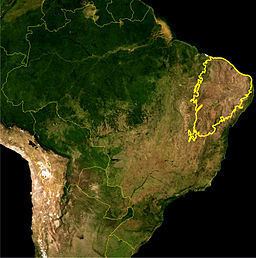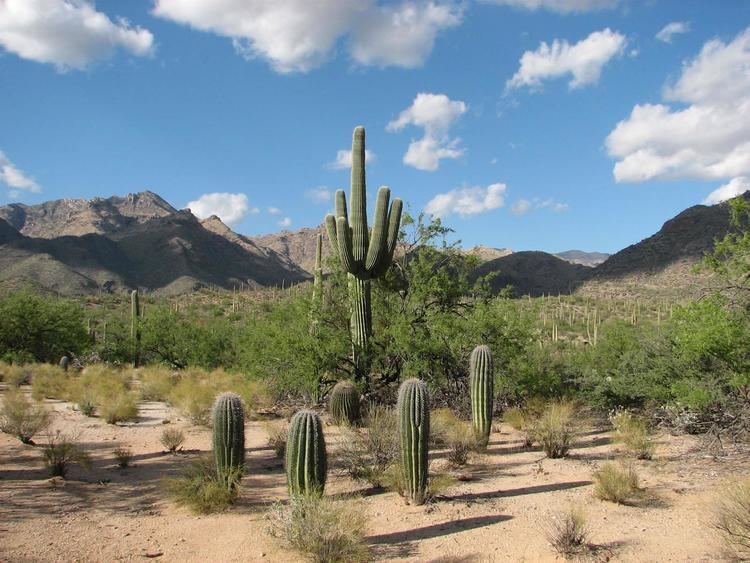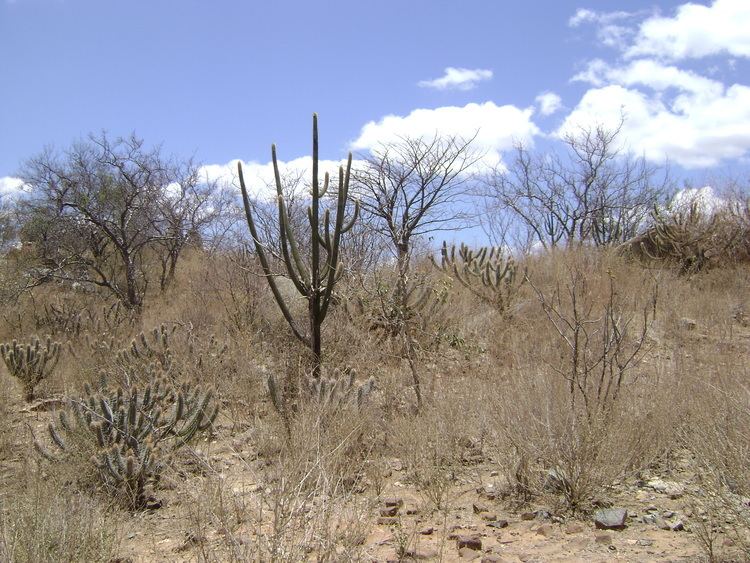Area 850,000 km² | ||
 | ||
Caatinga um bioma tipicamente brasileiro
Caatinga ([kaaˈtĩɡɐ]) is a type of desert vegetation, and an ecoregion characterized by this vegetation in interior northeastern Brazil. The name "Caatinga" is a Tupi word meaning "white forest" or "white vegetation" (caa = forest, vegetation, tinga = white).
Contents
- Caatinga um bioma tipicamente brasileiro
- Tropas especiais do ex rcito brasileiro caatinga
- Geography
- Climate
- Conservation
- Ecology
- Vegetation
- Fauna
- Economic exploitation
- Agriculture
- Irrigation
- Deforestation
- References

Caatinga is a xeric shrubland and thorn forest, which consists primarily of small, thorny trees that shed their leaves seasonally. Cacti, thick-stemmed plants, thorny brush, and arid-adapted grasses make up the ground layer. Many annual plants grow, flower, and die during the brief rainy season.

Caatinga falls entirely within earth's Tropical zone and is one of 6 major ecoregions of Brazil, including the Amazon Basin, Pantanal, Cerrado, Caatinga, Atlantic Forest, and Pampas. It covers 850,000 km², nearly 10% of Brazil's territory. It is home to 26 million people and more than 2000 species of vascular plants, fishes, reptiles, amphibians, birds, and mammals.

Tropas especiais do ex rcito brasileiro caatinga
Geography

Caatinga covers the interior portion of northeastern Brazil bordering the Atlantic seaboard (save for a fringe of Atlantic Forest). It is located between 3°S 45°W and 17°S 35°W, extending across eight states of Brazil: Piauí, Ceará, Rio Grande do Norte, Paraíba, Pernambuco, Alagoas, Sergipe, Bahia, and parts of Minas Gerais, as well the southeasternmost point of Rio de Janeiro in Cabo Frio. The Caatinga includes several enclaves of humid tropical forest, known as the Caatinga enclaves moist forests.
The Caatinga is bounded by the Maranhão Babaçu forests to the northwest, the Atlantic dry forests and the Cerrado savannas to the west and southwest, the humid Atlantic forests along the Atlantic coast to the east, and by the Atlantic Ocean to the north and northeast.
The Caatinga comprises 850,000 km², about 10% of the surface area of Brazil. By comparison, it is over nine times the surface area of Portugal, whence came its early European settlers, and 20% larger than the U.S. state of Texas.
Climate
The Caatinga has only two distinguishable seasons. These are the winter, when it is very hot and dry, and the summer when it is hot and rainy. During the dry winter periods there is no foliage or undergrowth. The vegetation is very dry and the roots begin to protrude through the surface of the stony soil. They do this in order to absorb water before it is evaporated. All leaves fall off the trees to reduce transpiration, thus lessening the amount of water that is lost in the dry season. During the peak periods of drought the Caatinga's soil can reach temperatures of up to 60 °C. With all the foliage and undergrowth dead during the drought periods and all the trees having no leaves the Caatinga has a yellow-grey, desert-like look.
The Caatinga is very dry place in Brazil, with frequent droughts. The drought usually ends in December or January, when the rainy season starts. Immediately after the first rains, the grey, desert-like landscape starts to transform and becomes completely green within a few days. Small plants start growing in the now moist soil and trees grow back their leaves. At this time, the rivers that were mostly dry during the past 6 or 7 months, start to fill up and the streams begin to flow again.
Conservation
The Caatinga is poorly represented in the Brazilian Conservation Area network, with only 1% in Integral Protection Conservation Areas and 6% in Sustainable Use Conservation Areas.
Ecology
Caatinga harbors a unique biota, with thousands of endemic species. Caatinga contains over 1,000 vascular plant species in addition to 187 bees, 240 fish species, 167 reptiles and amphibians, 516 birds, and 148 mammal species, with endemism levels varying from 9 percent in birds to 57 percent in fishes.
Vegetation
The caatinga does not correspond to a single type of vegetation, but is a broad mosaic of types. Towards the coast, the caatinga is replaced by remnants of the Atlantic Forest (Mata Atlântica); inland, the caatinga merges with no clear limits into the cerrado (see CPD Site SA21). Interspersed with the caatinga are low mountains with uplands that are much more humid, containing elements ("brejos de altitude") of the Atlantic and Amazonian forests, with trees 30–35 m tall.
General characteristics of the caatinga elements include total loss of leaves during the dry season, small and firm (xeric) leaves, intense branching of the trees from the base (giving them a shrubby appearance) and the presence of succulent and crassulaceous species (Romariz 1974). Most authors recognize two main types of caatinga: dry caatinga ("sertão") located in the interior and more humid caatinga ("agreste") toward the coast. Eiten (1983) divided the caatinga into the following eight categories:
1. Caatinga forest, or low (8–10 m) xerophytic deciduous tropical broadleaved forest, with closed canopies, and the trees having a ground coverage over 60%. This robust formation occurs where there is sufficient rain and the soil is deep enough.
2. Arborescent caatinga, with the shrubby subcanopy not closed, and tree coverage 10-60%.
3. Arborescent-shrubby closed caatinga, or low xerophytic deciduous open tropical broadleaved forest with closed scrub, where the tree coverage is 10-60%. This is the most common form of undisturbed caatinga, sometimes called "carrasco".
4. Arborescent-shrubby open caatinga, with the total ground coverage of trees, shrubs, cacti, bromeliads, etc. between 10-60%.
5. Shrubby closed caatinga, or xerophytic deciduous or semi-deciduous closed tropical broadleaved scrub; the thoroughly deciduous scrub is more common.
6. Shrubby open caatinga, or xerophytic open tropical scrub, which can be composed of deciduous broadleaved species, cacti and bromeliads, or mixtures of the same. Coverage varies between 10-60%. Common throughout the caatinga on very shallow soil or rocky outcrops.
7. Caatinga savanna or xerophytic short-graminose tropical savanna with deciduous broadleaved scrub; this formation is usually called "seridó".
8. Rocky caatinga savanna or xerophytic sparse tropical scrub, in which both scrub and graminose elements have ground coverage of less than 10%. This formation occurs on pavements and outcrops of massive rock, with the plants interspersed in cracks and hollows.
Fauna
The Caatinga is home to nearly 50 endemic species of birds, including Lear's macaw (Anodorhynchus leari), Spix's macaw (Cyanopsitta spixii), moustached woodcreeper (Xiphocolaptes falcirostris), Caatinga parakeet, Caatinga antwren, Sao Francisco black tyrant and Caatinga cacholote.
Endemic mammal species include:
Economic exploitation
People use many plant species from the Caatinga region. Palms are very important to the economy in northeast Brazil. People from this area are greatly dependent on extraction from babassu, carnaúba, tucúm and macaúba, from which lauric and oleic oils are made from. Many trees are also used for lumber in this area, including these species: Anadenanthera macrocarpa, Ziziphus joazeiro, Amburana cearensis, Astronium fraxinifolium, Astronium urundeuva, Handroanthus impetiginosus, Tabebuia caraiba, and Schinopsis brasiliensis, Cedrela odorata, Dalbergia variabilis, Didymopanax morototoni and Pithecellobium polycephalum. Some plants are also used for medical purposes.
Meliponiculture is also a well-developed and traditional activity in the region. One of the most productive species Melipona subnitida, known locally as jandaíra, produces up to 6 liters a year, resulting in economic profit for the population.
Around 26 million people live in the Caatinga region, and are regarded as belonging to the poorest inhabitants of Brazil. A very large part of the population depends on agricultural or forest industries for over half of their income. There are few drinkable water sources, and harvesting is difficult because of the irregular rainfall.
Agriculture
Along São Francisco River, the Caatinga has very fertile soil. Inhabitants plant fruits in the fertile soil to process and eat, sell and export. The irrigated farms along the São Francisco River in the municipalities of Petrolina and Juazeiro are currently exporting grapes, papayas and melons. Despite the amount of fertility, many farmers earn less than $1 a day.
Irrigation
Some regions are being irrigated, most notably the São Francisco River. While this is very good news for some farmers, it has also had serious consequences for people who have always depended on the natural flow of the river. Big dams have brought an end to the high tides in the rainy season, which used to spread fertile mud over the fields creating a rich ground that could be used for agriculture during the dry season. Salinization of the soil is becoming a threat since large areas of the land are irrigated with saline water, thus sterilizing the soil.
Deforestation
Having and using all these resources has some negatives. Intensive agriculture, along with excessive grazing by cattle and goats, is affecting the population structure of some important plant and animal species. Deforesting for industrial uses like fuel and charcoal destroys the vegetation. The combination of drought and misuse of the land is becoming a major threat. Harvesting of the caraiba woodland for lumber has reduced its size. This reduction may have contributed to the endangerment of the Spix's Macaw.
